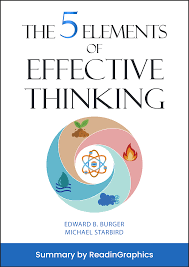Leveraging the Five Elements of Effective Thinking for Engineering Innovation: IAS Research as a Case Study
Abstract
Engineering innovation demands both technical mastery and adaptive problem-solving frameworks. The Five Elements of Effective Thinking—understand deeply, make mistakes, raise questions, follow the flow of ideas, and change—offer a structured methodology to drive creativity, resilience, and continuous improvement. This paper explores how IAS Research (ias-research.com), a multidisciplinary research and innovation organization, applies these principles to deliver transformative solutions in AI, IoT, automation, and digital transformation. Through case studies and methodological insights, the paper demonstrates how effective thinking enhances engineering outcomes and enables organizations to thrive amid complexity and uncertainty.
Introduction
Engineering and innovation thrive at the intersection of knowledge, creativity, and adaptability. Edward Burger and Michael Starbird’s Five Elements of Effective Thinking [4][5] provide a practical framework for problem-solving and discovery that extends well beyond education into real-world engineering practice. IAS Research, a global group of scientists and engineers, actively employs these elements in multidisciplinary projects, demonstrating their application in complex, high-stakes environments.
The Five Elements and Their Engineering Impact
1. Understand Deeply
Deep comprehension of fundamentals is critical before advancing to novel designs. For engineers, this means mastering principles of systems engineering, materials science, and algorithms before layering advanced applications such as machine learning or robotics. IAS Research emphasizes structured learning and foundational mastery, ensuring robust, scalable solutions.
2. Make Mistakes
Failure is an essential driver of innovation. Prototyping, controlled experimentation, and iterative design reveal weaknesses that lead to breakthroughs. IAS Research integrates rapid prototyping into AI, IoT, and drug discovery pipelines, treating mistakes as catalysts for refinement rather than setbacks [2].
3. Raise Questions
Progress often emerges from asking bold, challenging questions: What if? Why not? How else? Engineers at IAS Research are trained to push boundaries, questioning assumptions about cybersecurity models, industrial IoT frameworks, and adaptive energy systems to unlock new solutions [1][4].
4. Follow the Flow of Ideas
Innovation thrives on tracing the evolution of concepts and leveraging prior discoveries. IAS Research connects insights across disciplines—combining AI with embedded systems, or cybersecurity with human factors—to accelerate knowledge transfer and solution development [7][5].
5. Change
Adaptability is the essence of sustainable innovation. By embracing change as a constant, IAS Research helps organizations navigate uncertainty in digital transformation, regulatory shifts, and technological disruption [7][1].
Application at IAS Research
Cross-Disciplinary Collaboration
IAS Research unites engineers, data scientists, and business strategists, creating holistic solutions that address both technical and organizational challenges [2][8].
Prototyping and Iteration
Projects in AI-driven logistics, adaptive cybersecurity, and biomedical innovation employ rapid prototyping cycles, reducing time-to-market and ensuring robust validation [2].
Thriving in Ambiguity
IAS Research develops frameworks for AI integration, cybersecurity resilience, and IoT deployment that allow organizations to remain agile under uncertainty [2].
Case Studies
- AI-Driven Logistics – Machine learning models optimize supply chain routes, integrating real-time IoT data to enhance efficiency and reduce carbon footprints.
- Adaptive Cybersecurity – By questioning conventional security paradigms, IAS Research develops adaptive, AI-enhanced threat detection systems for critical industries.
- Drug Discovery Prototyping – Rapid prototyping accelerates the identification of promising compounds by combining computational biology with AI-assisted simulations.
Discussion
By systematically applying the five elements of effective thinking, IAS Research fosters resilient, scalable, and innovative solutions. These principles not only enhance problem-solving but also embed adaptability and creativity into the organization’s culture. The case studies highlight that innovation is not a linear path—it is iterative, inquiry-driven, and anchored in both mistakes and breakthroughs.
Conclusion
Engineering innovation is sustained by deep understanding, the willingness to make mistakes, curiosity, the evolution of ideas, and openness to change. IAS Research exemplifies this philosophy, integrating systems engineering, AI, and cross-disciplinary expertise to deliver transformative outcomes in manufacturing, healthcare, cybersecurity, and beyond. The five elements of effective thinking thus serve as a guiding framework for innovation-driven organizations navigating the complexity of the modern technological landscape.
References
[1] Goswami, A. 5 Elements of Effective Thinking. LinkedIn.
[2] IAS Research. The Art of Innovation and Its Application in IAS Research. ias-research.com.
[3] IAS Research. About Us. ias-research.com.
[4] Vardy, M. Book Review: The Five Elements of Effective Thinking. mikevardy.com.
[5] Mentorist. The 5 Elements of Effective Thinking. mentorist.app.
[6] Location Rebel. Effective Thinking. locationrebel.com.
[7] Farnam Street. The Elements of Effective Thinking. fs.blog.
[8] IAS Research. Consulting Engineering Services. ias-research.com.
[9] IAS Research. Critical Business Skills for Engineering and Innovation. ias-research.com.
[10] Manas Saloi. Summary: Five Elements of Effective Thinking. manassaloi.com.



